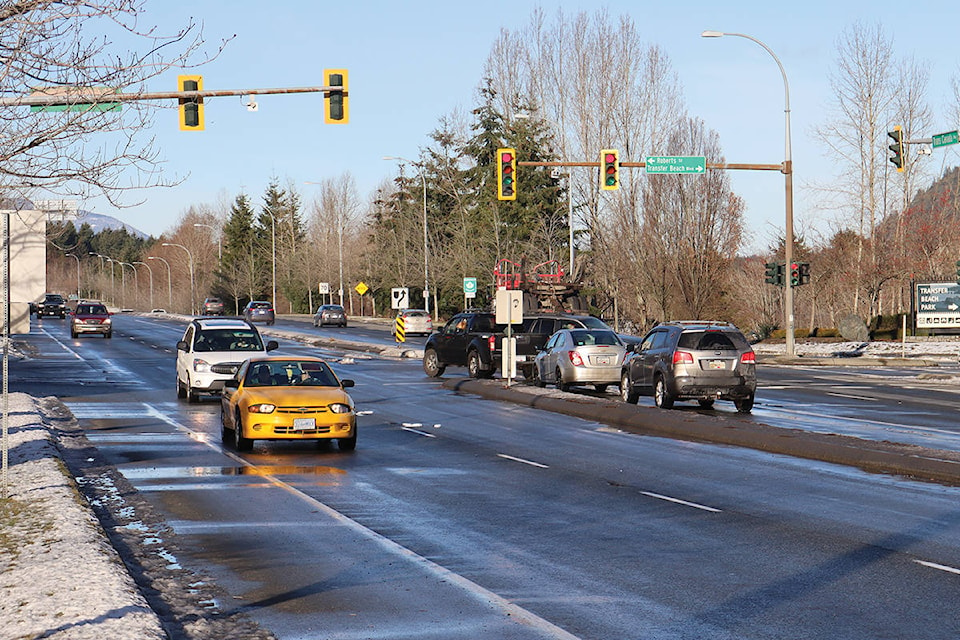Wet, icy, slushy, and sometimes snowy roads are a regular part of wintertime driving in Ladysmith. Now that the winter solstice has passed, it’s time for the annual reminder to shift into winter driving.
Ladysmith RCMP Staff Sgt. Wes Olsen is no stranger to winter driving. Olsen spent 20 years of his career in Manitoba, and in that time picked up some hard earned wisdom on winter road safety.
“Even though we live in a warmer climate, winter tires (snowflake or ice rating) are recommended for temperatures of 7 degrees Celsius and below. Standard all season tires that have the M+S rating (mud and snow) are the minimum requirement but the snowflake or ice rated tires are made up of a softer compound that helps them stick better to slippery road conditions,” he said.
Olsen also cautioned drivers to take special care while driving over bridges, as bridges tend to freeze up in lower temperatures.
“The bridge on the Old Chemainus Road at Saltair is a good example of this as we have already had some collisions there as drivers are sliding into oncoming traffic or the guard rail when the temperature drops and the surface of the bridge ices over,” he said.
RELATED: Pedestrian airlifted to Victoria after accident in Saltair
Aside from making sure that their car is equipped with the proper tires for the season, Olsen said one of the best pieces of advice is for drivers to slow down.
“The posted speed limit is the recommended speed under ideal driving conditions. Drivers need to adjust their speed to the weather and road conditions to increase traction and stopping ability. Maintain a greater distance between you and the vehicle in front of you.”
“Give yourself more time to travel to your intended destination so you don’t push your speed in wet, slippery road conditions,” Olsen added.
According to collision data compiled by the Ladysmith RCMP, there were 91 reported collisions along the Trans-Canada Highway from South Davis to Grouhel Road between Jan. 1 2018, and Dec. 17 2020.
The Ministry of Transportation and Infrastructure retained a consultant in 2018 to study six highway intersections in Ladysmith and has recommended multiple improvements to better manage the flow of vehicles along the Trans-Canada Highway corridor through town.
That study found that along the entire study corridor, the existing vehicle operating speed along the TCH is approximately 10 km/h to 25 km/h higher than the posted speed limit.
For this reason, reducing the speed limit through Ladysmith was seen as ineffective, and could result in dangerous speed differentials between those following a reduced speed limit, and drivers who are accustomed to driving faster than the current 70 km/h limit.
Instead, the study recommended increased traffic enforcement to deter speeding.
Mark Kusznir, owner of Central Island Towing, said that every intersection that crosses the TCH from the Nanaimo Airport to Thicke Road has seen multiple collisions, but he doesn’t blame the intersections.
“In my opinion, none of this is because of problems with the intersections. Every collision that I’ve been to I can attest to driver error. Somebody is just in a hurry, and made a judgmental mistake that caused the collision.”
One of the biggest ‘judgmental mistakes’ Kusznir sees time and time again is excessive speeding.
“For the size of our community, I would say we have a high number of excessive speed impounds,” he said. “People don’t pay attention — plain and simple. They miss the signs and they’re in such a rush to get to where they’re going. That extra 30 seconds apparently makes a big difference to their day.”
Kusznir said that the Oyster Bay intersection is particularly collision prone, as is the intersection at the Nanaimo Airport, and the Cedar Road intersection.
RELATED: One person dead after crash in front of Nanaimo Airport
RELATED: Driver pulled from fiery crash on the highway in Cassidy
“Everyone one of these intersections has got good sight lines, and there’s nothing there that would tell me that it’s a design flaw.”
The MOTI study largely reached the same conclusion as Kusznir. However, the study did recommend closing the eastbound left-turn out lane at Grouhel Road at the TCH — since 75 percent of collision there are left-turn 90 degree collisions.
The study also recommended only allowing the TCH and South Davis Road intersection to be used by motorists for right-in, right-out turns and left-in movements. This proposed change means motorists could no longer turn left from South Davis Road into the northbound highway lanes.
Any actions involving the highway are in the MOTI’s jurisdiction.
Some of Ladysmith’s most collision prone intersections are the intersection of the TCH and Davis Road, which has seen 19 collisions since 2018. The intersection of Roberts Street and Transfer Beach Boulevard at Esplanade totaled 14 collisions. Five collisions were recorded at Grouhel Road and the TCH.
MOTI study data collected from 2011 - 2015 shows that the TCH and Davis Road had 49 collisions over that period; Roberts Street and Transfer Beach Boulevard at Esplanade had 26; and Grouhel Road had 23.
